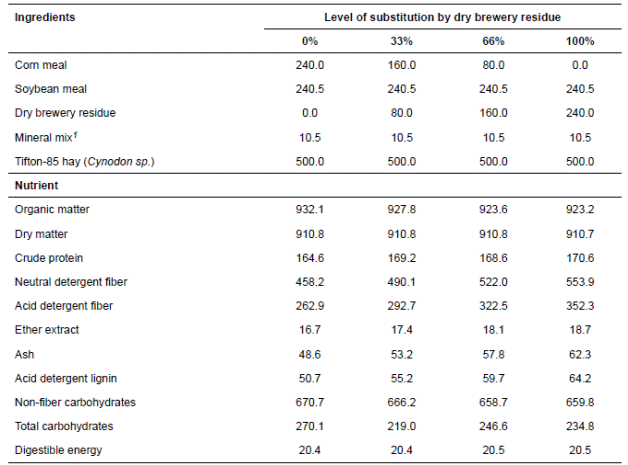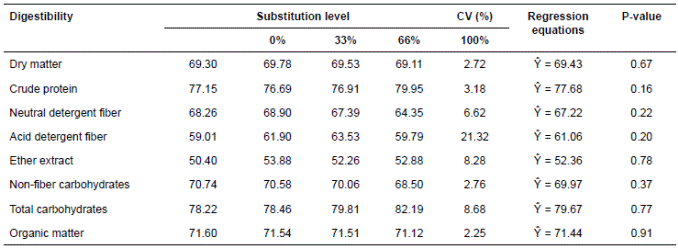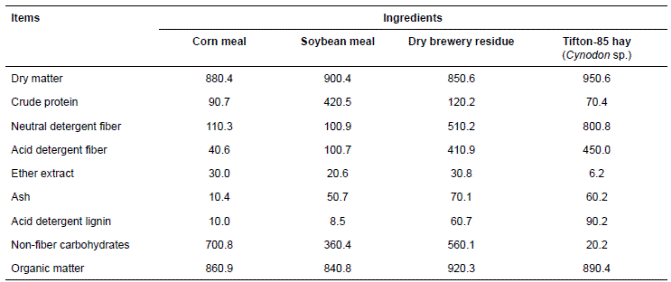Introduction
Small ruminants are able to utilize lingo-cellulosic materials and convert them to products of high nutritional value (meat, milk, wool, hide, and manure). For an animal to achieve the desired performance, a rich diet and practices that optimize welfare and performance are essential (Aguayo-Ulloa et al., 2014). These diets are needed for lambs fattened in arid environments where they experience chronic stress. Even in ruminants with the ability to use low quality, food an unbalanced diet directly influences feeding behavior, performance, and production (Martins et al., 2012). Therefore, it is critically important to assess feed alternatives because feed limitation restricts production due to frequent shortages of vegetation during the dry season and the high cost of feeds.
Agro-industrial byproducts have an important economic role as supplements, and are often responsible for the viability of the system; however, the use of such byproducts in animal diets must be carefully considered because their nutritional characteristics and availability may limit their use (Borja et al., 2010; Ribeiro et al., 2011; Moreira et al., 2014). In particular, the fiber content of such byproducts (Torreão et al., 2014) may limit intake, digestibility and animal performance (Sun and Oba, 2014).
Dry brewery residue is widely available. It was considered to be an environmental problem until recently, given that approximately 25% of the material used in the brewing process becomes residual byproducts (Gilaverte et al., 2011).
Feed value is based not only on the sum of its components or nutrients but also on the overall quality of food and the extent to which it can be digested, assimilated and utilized by animals. Although few data are available concerning sheep feedlots, feed value is currently based on the difference in energy content between waste byproducts and corn meal, which is the source of energy by default (Castro-Perez et al., 2014). Thus, the use of dry brewery residue in sheep diets has been hypothesized to increase intake and digestibility without negatively affecting feeding behavior. The use of this material may become important for reducing production costs. Thus, this study aimed to evaluate the optimal substitution level of corn meal with dry brewery residue in the diet of sheep.
Material and methods
Ethical considerations
This study was conducted in strict accordance with the recommendations presented in the Guide for the National Council for Animal Experiments Control (CONCEA). The protocol was approved by the Ethics Committee on Animal Experimentation of the Federal University of Bahia (Bahia State, Brazil) (Permit Number: 17-2014).
Animals
This study was conducted at the Experimental School of Veterinary and Animal Science of the Federal University of Bahia, located in Salvador, Bahia (Brazil). Twenty non-castrated, dewormed sheep of undefined breed (SPRD) with 30.33 ± 4.94 Kg initial 2 body weight and aged between 6 and 8 months were used. Animals were individually housed in 1.0 m pens with suspended wooden floors and fitted with feeders and drinkers.
Experimental feeds and chemical analyses
Dietary treatments consisted of 0, 33, 66, and 100% replacement of corn meal with dry brewery residue. Concentrates were formulated with corn meal, soybean meal and dry brewery residue. The forage:concentrate ratio was 50:50, and we used Tifton-85 hay (Cynodon sp.) as forage (Table 1).
Diets were offered twice daily in the form of a total mixed ration (TMR) at 9 and 16 h and adjusted to allow 10% leftovers. Individual intake per animal is expressed in g/animal/day, % of body weight and g/ Kg 0,75 (Brody, 1945).
The experiment lasted 25 days, including a 10-day pre-trial period for adaptation to the diets, facilities and management, and 15 days of data collection. Total fecal excretion was collected from day 20 to 25 to estimate apparent digestibility. Collection from individual animals during each period was performed using bags (Apack, Salvador City, Bahia State, Brazil) that were fixed to each animal. Feces were collected at the end of each day and stored in a freezer at -10 °C until further analysis.
Weighed samples of feed and leftovers from each animal were collected during the experimental period (from 10 to 25 days). Samples were packed in plastic sacks, labeled, and stored in a freezer at -10 °C until analyzed in the laboratory. Average water intake was daily measured throughout the experimental period using five-liter graduated drinkers (bucket type) to calculate volume consumed.
Samples of feed scraps and feces were pre-dried at 55 °C for 72 hours, ground using a Wiley mill (Tecnal, Piracicaba City, São Paulo State, Brazil) with a 1 mm sieve, stored in air-tight plastic container (ASS, Ribeirão Preto City, São Paulo State, Brazil), and sealed properly until laboratory analysis for concentration of DM (Method 967.03 - AOAC, 1990), ash (Method 942.05 -AOAC,1990), CP (Method 981.10 - AOAC, 1990), and EE (Method 920.29 - AOAC, 1990). The NDF content was quantified using Van Soest et al. (1991) methodology with modifications proposed in the Ankom device manual (Ankom Technology Corporation, Macedon, New York, US). The ADF content was analyzed according to the method of Goring and Van Soest (1970). Acid detergent lignin (ADL) was quantified according to method 973.18 (AOAC, 2002), in which the ADF residue was treated with 72% sulfuric acid. The proportion of ingredients and chemical composition are shown in Table 2.
Table 2 Proportions and chemical composition (g/Kg DM) of ingredients in the experimental diets.

1 The mineral mixture per Kg was as follows: 190 g calcium, 73 g phosphorus, 44 g magnesium, 62 g sodium, 92 g chloride, 30 g sulfur, 1,350 mg zinc, 340 mg copper, 940 mg manganese, 1,064 mg iron, 3 mg cobalt, 16 mg iodine, 18 mg selenium and 730 mg fluoride.
Total carbohydrate (TC) values were determined using the equation described by Sniffen et al. (1992): TC = 100 - (%CP + %EE +%Ash). In addition, the levels of non-fiber carbohydrates (NFC) were determined using the following equation: NFC = TC - NDF (NRC, 2001). To calculate intake of total digestible nutrients (TDN) we used the formula proposed by Sniffen et al. (1992): iTDN = (iCP - fCP) + 2.25 (iEE - fEE) + (iCHO - fCHO), in which iCP, iEE, and iCHO represent the intake of CP, EE, CHO, respectively, while fCP, fEE, and fCHO represent the excretion of CP, EE, and CHO, respectively.
Ingestive behavior
Behavioral activity was assessed by observing each animal. Trained observers were positioned to ensure that they interfered as little as possible with animal behavior. Observers recorded the time animals spent on activities of eating, ruminating and idling in five-minute intervals over a 24-hour period, as described by Johnson and Combs (1991). Artificial lighting was used during the night to facilitate feeding behavior observations.
Statistical analyses
We used a randomized complete block design for performance and behavior tests, with four treatments and five blocks defined according to the initial weight of the animals, using the following model:
Yijk = M + Bi + Dj + Eij
Where:
M = average.
B i = effect of the block (i = 1 to 5).
D j = effect of supplementation with dry residue brewer (0, 33, 66, and 100%; j = 1 to 4).
E ij = error associated with the ij observation.
Block was included as a random effect. The variables were analyzed using the MIXED procedure of SAS® (1999) statistical software, version 8.2 (SAS Inst. Inc, Cary, NC, USA). The averages were obtained using the LSMEANS command. The effects of level of dry brewer residue substitution in the diets were evaluated using linear and quadratic orthogonal polynomials. The observed effects were declared significant when p<0.05.
Results
Total and Kg/day dry matter intake, as well as percentage of body weight (g/Kg) of metabolic weight did not change (p>0.05) with the level of dry brewery residue substitution (Table 3).
Table 3 Nutrient intake in sheep fed diets containing dry brewery residue as a replacement for corn meal.

Data are presented as means; coefficients of variation (CV); adjusted regression equations (RE) and significance (P).
Although no differences were observed among treatments, dry matter intake in body weight (% and g/Kg) showed increases of 17 and 16%, respectively, for the group that received no residue relative to the group fed 66% dry brewery residue. The maximum DM intake was 1.10 Kg/day and was observed with 66% dry brewery residue inclusion, which corresponded to 3.65% body weight. Water intake was not affected by the quantity of dry brewery residue (p>0.05). However, there was a 25% decrease between the treatment with the highest level (100%) of brewery residue and the control treatment (no dry brewery residue). The average water intake was 2.5 liters per day. As shown in Table 2, the composition of the diet was not altered in terms of dry matter and digestible energy. Average crude protein intake was 0.27 Kg/day, neutral detergent fiber intake was 0.53 Kg/day, ether extract was 0.01 Kg/day, nonfiber carbohydrate intake was 0.15 Kg/day, total carbohydrate intake was 0.68 Kg/day, and organic matter was 0.95 Kg/day for animals fed dry brewery residue.
Digestibility coefficients (Table 4) showed no significant differences for substitution of corn meal with dry brewery residue (p>0.05).
Table 4 Nutrient digestibility in sheep fed diets containing dry brewery residue as a replacement for corn meal.

Data are presented as means; coefficients of variation (CV); and adjusted regression equations (RE); data were significant when p<0.05.
The inclusion of brewery residue in the diets did not affect duration of feeding and idling times (Table 5). However, the ruminating time (min/day) was a quadratic function of the level of substitution (p<0.05). There was a reduction in ruminating time at the 33% substitution level and an increase in ruminating time at the 66 and 100% levels.
Discussion
The similar intake observed for all the treatments stemmed from the similarity in composition of the experimental diets. Thus, an increase of 12% lignin composition in the diet resulted in an increase in the contents of NDF and ADF and a consequent increase in dry matter intake in the form of body weight percentage as g/Kg0.75 , although this difference was not detected by the statistical test due to variability in the data. Dry matter intake may be influenced by high concentration of dietary fiber, which may limit the ingestive ability of the animals due to rumen filling. However, in this study, fiber intake had no effect on DM intake, which demonstrates that physical characteristics of fiber had no effect on ingestive ability, and the proportion of dietary fiber did not affect physiological functioning of the rumen.
Nutrient intake (CP, NDF, ADF, and EE) did not differ among diets. This can be explained by the formation of dry brewery residue from barley, which has a high content of non-structural carbohydrates. Therefore, corn meal could be replaced without altering the nutritional content of the diets. With respect to water intake, there was a trend of decreased intake after replacing corn meal with dry brewery residue. However, this decrease was not significant, thus confirming that animals accepted the substitution of corn meal with dry brewery residue and that dry brewery residue did not alter any of the physiological standards that affect water intake. The inclusion of dry brewery residue in the concentrated feed is a viable alternative to supply energy for sheep. In addition to providing a source of yeast (Saccharomyces cerevisiae and S. uvarum) with saccharification enzymes (Wang et al., 2014), the residue also provides a flavor that improves palatability, despite having no influence on intake based on the findings. Data show that the dry brewery residue is accepted by sheep at similar rates to corn meal. All treatments resulted in total ingested water that exceeded 0.80 Kg/day (NRC, 2007), recommended for sheep by international committees.
Digestibility coefficients did not change with the inclusion of dry brewery residue. In an experiment with cattle, Geron et al. (2008) observed results similar to those found here: the inclusion of up to 24% brewery residue in the diet did not alter nutrient digestion, ruminal fermentation, nor the efficiency of microbial synthesis. The CP exhibited default behavior with all treatments. Protein composition of dry brewery residue had high values for the B2 and B3 fractions (Pereira et al., 1998) and low ruminal degradability, which together increases amino acid intake in ruminants, especially the intake of essential amino acids.
With respect to NDF and ADF digestibility, the quantities included in the diets demonstrate that the large amount of NFC in brewery residue may facilitate a greater intake of physically effective fiber. More relevant to overall digestibility is the digestibility of fiber itself and its overall proportion in the feed. Even if fiber digestibility is low, the fact that feed has less NDF makes it more digestible. Thus, an increase in OM lignin digestibility is correlated with elevated levels of NFC because the cellular content is close to 100% true digestibility (Mizubuti et al., 2014).
Substitution of corn meal with dry brewery residue did not significantly alter intake and digestibility of NDF, ADF, NFC, and TC, demonstrating that animals regulate the digestion rate of proteins and carbohydrates, keeping TDN intake stable at an average of 71.26%. According to Cabral et al. (2003), the highest level of CNF, represented by fractions A + B1, theoretically increases TDN content because these carbohydrates are almost totally available to ruminants. However, in the present study, NFC levels reflected TDN level. This inconsistency may have occurred because these higher levels were not sufficient to raise the energy content based on TND calculation, which considers other nutrients capable of generating energy, such as carbohydrates and digestible proteins (Brochier and Carvalho, 2008).
Time spent ruminating depended on the proportion of dry brewery residue in the diet, as indicated by a significant quadratic effect. Although DM and NDF values -important variables to predict uminationremained constant for all treatments, more time was spent on rumination when 41.58% of corn meal was replaced by dry brewery residue, as illustrated by the value of 592.64 min/day. The results are consistent with standard ruminant feedlot behavior.
In conclusion, dry brewery residue can completely replace corn meal in the total mixed ration or in the concentrate without negative effects on intake, digestibility or feeding time in sheep.
















